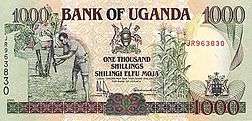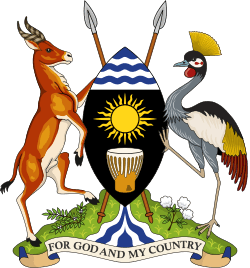Ugandan shilling
| Ugandan shilling | |
|---|---|
| Shilingi ya Uganda (Swahili) | |
|
The old 1000-shilling note depicted a farmer on one side and grain storage on the reverse. | |
| ISO 4217 | |
| Code | UGX |
| Denominations | |
| Subunit | |
| 1/100 | cent |
| Symbol | USh |
| Banknotes | 1000, 2000, 5000, 10,000, 20,000, 50,000 shillings |
| Coins | |
| Freq. used | 50, 100, 200, 500 shillings |
| Rarely used | 10 shillings |
| Demographics | |
| User(s) |
|
| Issuance | |
| Central bank | Bank of Uganda |
| Website |
www |
| Valuation | |
| Inflation | 4.7% |
| Source | The World Factbook, 2014 est. |
The shilling (sign: USh; code: UGX) is the currency of Uganda. Officially divided into cents until 2013, the shilling now has no subdivision.[1]
History
The first Ugandan shilling (UGS) replaced the East African shilling in 1966 at par. Following high inflation, a new shilling (UGX) was introduced in 1987 worth 100 old shillings.
The shilling is usually a stable currency and predominates in most financial transactions in Uganda, which has a very efficient foreign exchange market with low spreads. The United States dollar is also widely accepted. The pound sterling and increasingly the euro are also used.
The Bank of Uganda cut its policy rate to 22% on 1 February 2012 after reduction of inflation for 3 consecutive months.[2]
Coins
First shilling
In 1966, coins were introduced in denominations of 5, 10, 20 and 50 cents and 1 and 2 shillings. The 5, 10 and 20 cent coins were struck in bronze, with the higher denominations struck in cupro-nickel. The 2 shilling was only issued that year. In 1972, cupro-nickel 5 shilling coins were issued but were withdrawn from circulation are now very rare. In 1976, copper-plated steel replaced bronze in the 5 and 10 cent and cupro-nickel-plated steel replaced cupro-nickel in the 50 cent and 1 shilling. In 1986, nickel-plated-steel 50 cent and 1 shilling coins were issued, the last coins of the first shilling.
Second shilling
In 1987, copper-plated-steel 1 and 2 shilling and stainless-steel five and ten shilling coins were introduced, with the five and ten shilling curved-equilateral heptagonal in shape. In 1998, coins for fifty, 100, 200 and 500 shillings were introduced. Denominations currently circulating are 50, 100, 200, 500, and 1,000 shillings.[3]
Banknotes
First shilling
In 1966, the Bank of Uganda introduced notes in denominations of 5, 10, 20 and 100 shillings. In 1973, 50 shilling notes were introduced, followed by 500 and 1000 shillings in 1983 and 5000 shillings in 1985.
Second shilling
In 1987, notes were introduced in the new currency in denominations of 5, 10, 20, 50, 100 and 200 shillings. In 1991, 500 and 1000 shilling notes were added, followed by 5000 shillings in 1993, 10,000 shillings in 1995, 20,000 shillings in 1999, 50,000 shillings in 2003 and 2000 shillings in 2010. Banknotes currently in circulation are 1000, 2000, 5000, 10,000, 20,000 and 50,000 shillings. In 2005, the Bank of Uganda was considering whether to replace the low value notes such as the 1000 shilling with coins. The lower denomination notes take a battering in daily use, often being very dirty and sometimes disintegrating.[4]
On 17 May 2010, the Bank of Uganda issued a new family of notes featuring a harmonized banknote design that depict Uganda’s rich historical, natural, and cultural heritage. They also bear improved security features. Five images appear on all the six denominations: Ugandan mat patterns, Ugandan basketry, the map of Uganda (complete with the equator line), the Independence Monument, and a profile of a man wearing Karimojong headdress. Bank of Uganda Governor Emmanuel Tumusiime Mutebile said the new notes did not constitute a currency reform, nor were they dictated by politics. The redesign, he said, was driven by the need to comply with international practices and to beat counterfeiters. Uganda is the first African country to introduce the advanced security feature SPARK[5] on a regular banknote series. SPARK is an optical security feature recognised by central banks worldwide and is used on a number of banknotes for protection against counterfeiting.
| Current UGX exchange rates | |
|---|---|
| From Google Finance: | AUD CAD CHF EUR GBP HKD JPY USD |
| From Yahoo! Finance: | AUD CAD CHF EUR GBP HKD JPY USD |
| From XE: | AUD CAD CHF EUR GBP HKD JPY USD |
| From OANDA: | AUD CAD CHF EUR GBP HKD JPY USD |
| From fxtop.com: | AUD CAD CHF EUR GBP HKD JPY USD |
As of 22 August 2011, one US Dollar (USD) = 2800 Ugandan Shillings (UGX). The exchange rate dropped to USD 1 = UGX 2901 in September 2011, and it bounced back to USD 1 = UGX 2303 on 13 February 2012.[6]
See also
References
- ↑ "ISO 4217 Amendment Number 155". Retrieved 2013-04-11.
- ↑ "Uganda shilling little changed but seen weakening". Reuters. Retrieved 2012-02-13.
- ↑ http://en.numista.com/catalogue/ouganda-2.html
- ↑ Bank of Uganda To Conduct Poll On 1,000 Shilling Note Vs Coin
- ↑ "SPARK trademark registration".
- ↑ Historical Exchange Rates:Uganda Shilling Vs United States Dollars
- Krause, Chester L.; Clifford Mishler (1991). Standard Catalog of World Coins: 1801–1991 (18th ed.). Krause Publications. ISBN 0873411501.
- Pick, Albert (1994). Standard Catalog of World Paper Money: General Issues. Colin R. Bruce II and Neil Shafer (editors) (7th ed.). Krause Publications. ISBN 0-87341-207-9.
External links
| Preceded by: East African shilling Reason: currency independence Ratio: at par Note: independent shilling introduced in 1966, but EA shilling not demonetized until 1969 |
Currency of Uganda 1966 – 1987 |
Succeeded by: Second Ugandan shilling Reason: inflation Ratio: 1 new shilling = 100 old shillings |
| Preceded by: First Ugandan shilling Reason: inflation Ratio: 1 new shilling = 100 old shillings |
Currency of Uganda 1987 – |
Succeeded by: Current |

